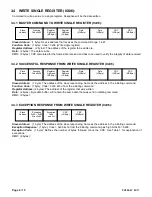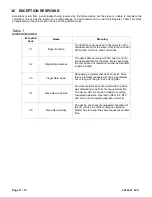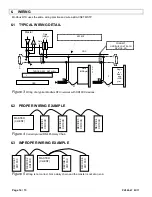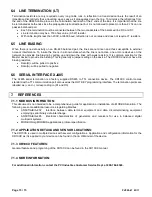
Page 3 / 15
PV500-67 03/17
1. THIS MANUAL
This is a supplemental manual to cover the communication interface capabilities of the XR10CX thermostatic module
using Modbus RTU. This manual will provide the particulars for the XR10CX, how the Modbus RTU protocol is
implemented on the XR10CX, and how to interface with the XR10CX. For details on how to operate or configure the
XR10CX, please refer to the XR10CX Manual.
This manual is not a complete or definitive guide to Modbus RTU communication. For detailed MODBUS and Modbus
RTU information, consult other sources such as (www.modbus.org).
2. MODBUS RTU:
2.1 OVERVIEW:
Modbus RTU This is a communication over twisted pair from a Master device (also called a client) to multiple slave
devices (also called servers). The master will send command to a particular slave. The slave will in turn process this
command and respond to the Master. All communication is initiated by the Master. The XR10CX is a slave device and
will not “talk” until a Master device talks to it first. Modbus RTU is widely used within Building Management Systems
(BMS) and Industrial Automation Systems (IAS). This wide acceptance is due in large part to Modbus RTU
’s ease of
use. Modbus RTU is a low level communications that contain no unit type, data scaling, or data description. Simply put,
it is a list of addresses that can be read and/or written to. The type of data will have to be known by the receiving device
in order for the data to be useful. Data types and available registers are usually provided as device documentation
register list.
2.1.1 DEFINITIONS:
MODBUS Protocol:
A messaging structure used for communication between devices, machines, sensors, and/or
computers.
Modbus-RTU: (Remote Terminal Unit)
Implementation of the Modbus protocol on top of a serial line with an RS-232,
RS-485 or similar physical layer. The XR10CX uses 2-wire RS-485 Physical Layer and implements Modbus RTU.
Master Device:
Also known as Client, this device initiates all communication on the RS-485 network. The Master will
send commands to Slave Devices.
Slave Device:
Also known as Server, this device will respond only when addressed by the Master device. When the
Master sends the slave a command, it will perform the command and respond back to the Master with the data
requested, or if no data is required, then it will simply echo the command.
Slave Address:
Each slave device in a network is assigned a unique address from 1 to 247. When the Master requests
data, the first byte it sends is the Slave address. This way each slave knows after the first byte whether or not to ignore
the message.
RS-485 (EIA-485):
A 2 wire (twisted pair) multi drop network. Each device can send data by holding positive and
negative voltage on the line and reversing polarity on the 2 wires. When no devices are transmitting, the line will be tri-
state. The recommended arrangement of the wires is as a connected series of point-to-point (multi-dropped) nodes,
i.e. a line or bus, not a star, ring, or multiply connected network. The number of devices that can be connected to a
single line is defined in the RS-485 standard by the input impedance of 32 UNIT LOADs. The wire and circuits
interfacing on this 2 wire connection is considered the PHYSICAL LAYER. (RS-485 is the same physical layer as used
with BACNET MSTP.)

































